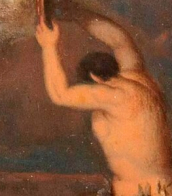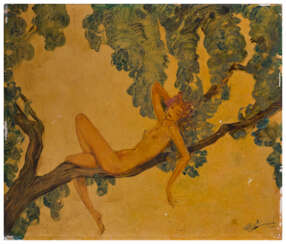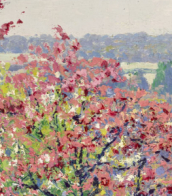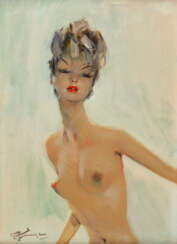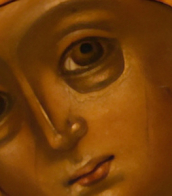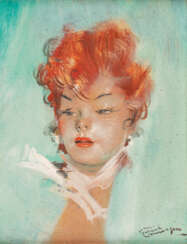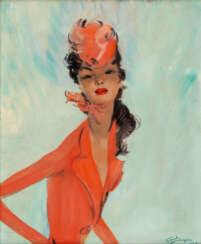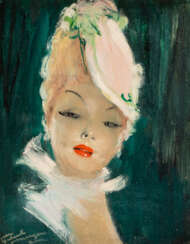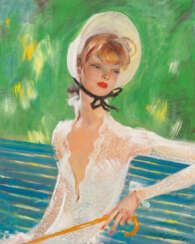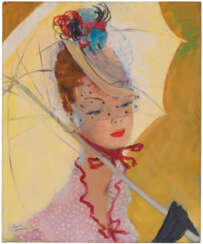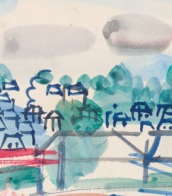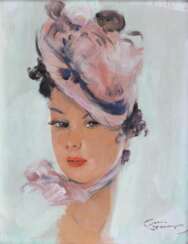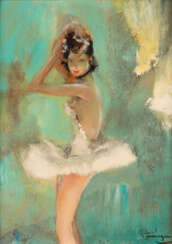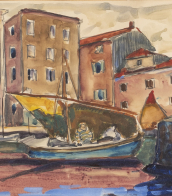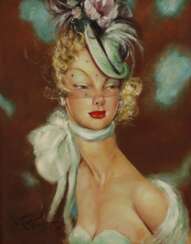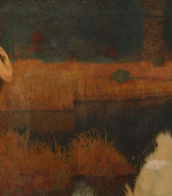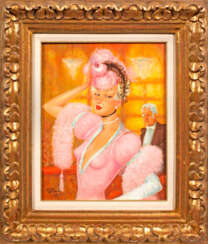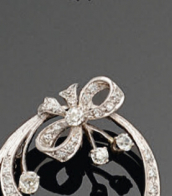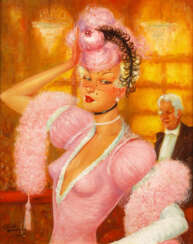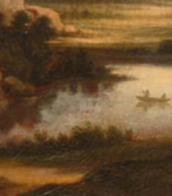jean-gabriel domergue (1889 - 1962)

Jean-Gabriel Domergue was a distinguished French painter, renowned for his portraits of Parisian women. His education at the École nationale supérieure des Beaux-Arts laid the foundation for his artistic journey. In 1911, Domergue's talents were recognized with the prestigious Prix de Rome, marking a significant milestone in his career.
Jean-Gabriel Domergue's artistic evolution, especially from the 1920s, was characterized by a focus on portraying the "Parisian lady." He claimed to be "the inventor of the pin-up" and is known for creating a new archetype of woman in his paintings: slender, elegant, with a swanlike neck and wide, longing eyes. This signature style saw him paint approximately 3,000 portraits, including prominent figures such as Liane de Pougy and Nadine, the future Baroness of Rothschild.
Beyond painting, Jean-Gabriel Domergue's influence extended to fashion. He collaborated with notable couturiers like Paul Poiret and Henry Marque, designing dresses, hats, and accessories. His role in shaping the fashion of his era was significant, reflecting his deep understanding of elegance and style.
Later in his life, Domergue also served as the curator of the Jacquemart-André Museum in Paris from 1955 until his passing in 1962. His tenure saw remarkable exhibitions featuring the works of Van Gogh, Toulouse-Lautrec, Goya, and others, including a tribute to his own master, Giovanni Boldini. Jean-Gabriel Domergue's contributions to art and culture earned him accolades, including being made a Knight of the Legion of Honour and a Fellow of the Academy of Fine Arts.
A notable aspect of Jean-Gabriel Domergue's legacy is the Villa Domergue in Cannes, a historic mansion he built. This villa was turned into a museum in his honor from 1962 to 1973 and is currently used as an official venue by the city of Cannes. It is recognized as an official historical monument and plays a role during the Cannes Film Festival.
For collectors and experts in art and antiques, Jean-Gabriel Domergue's work represents a unique blend of classic beauty and modern elegance. His paintings offer a window into the Parisian high society of the early 20th century and continue to be a source of inspiration and fascination. To stay informed about sales, auction events, and updates related to Jean-Gabriel Domergue, consider signing up for updates. This ensures access to the latest opportunities to engage with and appreciate the work of this influential French artist.
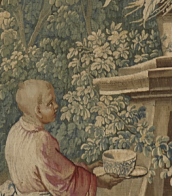

Jean-Gabriel Domergue was a distinguished French painter, renowned for his portraits of Parisian women. His education at the École nationale supérieure des Beaux-Arts laid the foundation for his artistic journey. In 1911, Domergue's talents were recognized with the prestigious Prix de Rome, marking a significant milestone in his career.
Jean-Gabriel Domergue's artistic evolution, especially from the 1920s, was characterized by a focus on portraying the "Parisian lady." He claimed to be "the inventor of the pin-up" and is known for creating a new archetype of woman in his paintings: slender, elegant, with a swanlike neck and wide, longing eyes. This signature style saw him paint approximately 3,000 portraits, including prominent figures such as Liane de Pougy and Nadine, the future Baroness of Rothschild.
Beyond painting, Jean-Gabriel Domergue's influence extended to fashion. He collaborated with notable couturiers like Paul Poiret and Henry Marque, designing dresses, hats, and accessories. His role in shaping the fashion of his era was significant, reflecting his deep understanding of elegance and style.
Later in his life, Domergue also served as the curator of the Jacquemart-André Museum in Paris from 1955 until his passing in 1962. His tenure saw remarkable exhibitions featuring the works of Van Gogh, Toulouse-Lautrec, Goya, and others, including a tribute to his own master, Giovanni Boldini. Jean-Gabriel Domergue's contributions to art and culture earned him accolades, including being made a Knight of the Legion of Honour and a Fellow of the Academy of Fine Arts.
A notable aspect of Jean-Gabriel Domergue's legacy is the Villa Domergue in Cannes, a historic mansion he built. This villa was turned into a museum in his honor from 1962 to 1973 and is currently used as an official venue by the city of Cannes. It is recognized as an official historical monument and plays a role during the Cannes Film Festival.
For collectors and experts in art and antiques, Jean-Gabriel Domergue's work represents a unique blend of classic beauty and modern elegance. His paintings offer a window into the Parisian high society of the early 20th century and continue to be a source of inspiration and fascination. To stay informed about sales, auction events, and updates related to Jean-Gabriel Domergue, consider signing up for updates. This ensures access to the latest opportunities to engage with and appreciate the work of this influential French artist.


Jean-Gabriel Domergue was a distinguished French painter, renowned for his portraits of Parisian women. His education at the École nationale supérieure des Beaux-Arts laid the foundation for his artistic journey. In 1911, Domergue's talents were recognized with the prestigious Prix de Rome, marking a significant milestone in his career.
Jean-Gabriel Domergue's artistic evolution, especially from the 1920s, was characterized by a focus on portraying the "Parisian lady." He claimed to be "the inventor of the pin-up" and is known for creating a new archetype of woman in his paintings: slender, elegant, with a swanlike neck and wide, longing eyes. This signature style saw him paint approximately 3,000 portraits, including prominent figures such as Liane de Pougy and Nadine, the future Baroness of Rothschild.
Beyond painting, Jean-Gabriel Domergue's influence extended to fashion. He collaborated with notable couturiers like Paul Poiret and Henry Marque, designing dresses, hats, and accessories. His role in shaping the fashion of his era was significant, reflecting his deep understanding of elegance and style.
Later in his life, Domergue also served as the curator of the Jacquemart-André Museum in Paris from 1955 until his passing in 1962. His tenure saw remarkable exhibitions featuring the works of Van Gogh, Toulouse-Lautrec, Goya, and others, including a tribute to his own master, Giovanni Boldini. Jean-Gabriel Domergue's contributions to art and culture earned him accolades, including being made a Knight of the Legion of Honour and a Fellow of the Academy of Fine Arts.
A notable aspect of Jean-Gabriel Domergue's legacy is the Villa Domergue in Cannes, a historic mansion he built. This villa was turned into a museum in his honor from 1962 to 1973 and is currently used as an official venue by the city of Cannes. It is recognized as an official historical monument and plays a role during the Cannes Film Festival.
For collectors and experts in art and antiques, Jean-Gabriel Domergue's work represents a unique blend of classic beauty and modern elegance. His paintings offer a window into the Parisian high society of the early 20th century and continue to be a source of inspiration and fascination. To stay informed about sales, auction events, and updates related to Jean-Gabriel Domergue, consider signing up for updates. This ensures access to the latest opportunities to engage with and appreciate the work of this influential French artist.


Jean-Gabriel Domergue was a distinguished French painter, renowned for his portraits of Parisian women. His education at the École nationale supérieure des Beaux-Arts laid the foundation for his artistic journey. In 1911, Domergue's talents were recognized with the prestigious Prix de Rome, marking a significant milestone in his career.
Jean-Gabriel Domergue's artistic evolution, especially from the 1920s, was characterized by a focus on portraying the "Parisian lady." He claimed to be "the inventor of the pin-up" and is known for creating a new archetype of woman in his paintings: slender, elegant, with a swanlike neck and wide, longing eyes. This signature style saw him paint approximately 3,000 portraits, including prominent figures such as Liane de Pougy and Nadine, the future Baroness of Rothschild.
Beyond painting, Jean-Gabriel Domergue's influence extended to fashion. He collaborated with notable couturiers like Paul Poiret and Henry Marque, designing dresses, hats, and accessories. His role in shaping the fashion of his era was significant, reflecting his deep understanding of elegance and style.
Later in his life, Domergue also served as the curator of the Jacquemart-André Museum in Paris from 1955 until his passing in 1962. His tenure saw remarkable exhibitions featuring the works of Van Gogh, Toulouse-Lautrec, Goya, and others, including a tribute to his own master, Giovanni Boldini. Jean-Gabriel Domergue's contributions to art and culture earned him accolades, including being made a Knight of the Legion of Honour and a Fellow of the Academy of Fine Arts.
A notable aspect of Jean-Gabriel Domergue's legacy is the Villa Domergue in Cannes, a historic mansion he built. This villa was turned into a museum in his honor from 1962 to 1973 and is currently used as an official venue by the city of Cannes. It is recognized as an official historical monument and plays a role during the Cannes Film Festival.
For collectors and experts in art and antiques, Jean-Gabriel Domergue's work represents a unique blend of classic beauty and modern elegance. His paintings offer a window into the Parisian high society of the early 20th century and continue to be a source of inspiration and fascination. To stay informed about sales, auction events, and updates related to Jean-Gabriel Domergue, consider signing up for updates. This ensures access to the latest opportunities to engage with and appreciate the work of this influential French artist.
